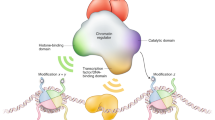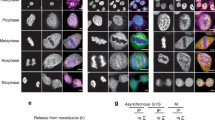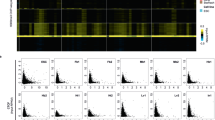Abstract
The transcriptional co-repressor CtBP (C-terminal binding protein) is implicated in tumorigenesis because it is targeted by the adenovirus E1A protein during oncogenic transformation1. Genetic studies have also identified a crucial function for CtBP in animal development2. CtBP is recruited to DNA by transcription factors that contain a PXDLS motif3,4, but the detailed molecular events after the recruitment of CtBP to DNA and the mechanism of CtBP function in tumorigenesis are largely unknown. Here we report the identification of a CtBP complex that contains the essential components for both gene targeting and coordinated histone modifications, allowing for the effective repression of genes targeted by CtBP. Inhibiting the expression of CtBP and its associated histone-modifying activities by RNA-mediated interference resulted in alterations of histone modifications at the promoter of the tumour invasion suppressor gene E-cadherin and increased promoter activity in a reporter assay. These findings identify a molecular mechanism by which CtBP mediates transcriptional repression and provide insight into CtBP participation in oncogenesis.
This is a preview of subscription content, access via your institution
Access options
Subscribe to this journal
Receive 51 print issues and online access
$199.00 per year
only $3.90 per issue
Buy this article
- Purchase on Springer Link
- Instant access to full article PDF
Prices may be subject to local taxes which are calculated during checkout





Similar content being viewed by others
References
Boyd, J. M. et al. A region in the C-terminus of adenovirus 2/5 E1a protein is required for association with a cellular phosphoprotein and important for the negative modulation of T24-ras mediated transformation, tumorigenesis and metastasis. EMBO J. 12, 469–478 (1993)
Chinnadurai, G. CtBP family proteins: More than transcriptional corepressors. BioEssays 25, 9–12 (2003)
Nibu, Y., Zhang, H. & Levine, M. Interaction of short-range repressors with Drosophila CtBP in the embryo. Science 280, 101–104 (1998)
Chinnadurai, G. CtBP, an unconventional transcriptional corepressor in development and oncogenesis. Mol. Cell 9, 213–224 (2002)
Ogawa, H., Ishiguro, K., Gaubatz, S., Livingston, D. M. & Nakatani, Y. A complex with chromatin modifiers that occupies E2F- and Myc-responsive genes in G0 cells. Science 296, 1132–1136 (2002)
Postigo, A. A. & Dean, D. C. ZEB represses transcription through interaction with the corepressor CtBP. Proc. Natl Acad. Sci. USA 96, 6683–6688 (1999)
Tachibana, M., Sugimoto, K., Fukushima, T. & Shinkai, Y. SET domain-containing protein, G9a, is a novel lysine-preferring mammalian histone methyltransferase with hyperactivity and specific selectivity to lysines 9 and 27 of histone H3. J. Biol. Chem. 276, 25309–25317 (2001)
Sewalt, R. G., Gunster, M. J., van der Vlag, J., Satijn, D. P. & Otte, A. P. C-terminal binding protein is a transcriptional repressor that interacts with a specific class of vertebrate Polycomb proteins. Mol. Cell. Biol. 19, 777–787 (1999)
Lahn, B. T. & Page, D. C. Retroposition of autosomal mRNA yielded testis-specific gene family on human Y chromosome. Nature Genet. 21, 429–433 (1999)
You, A., Tong, J. K., Grozinger, C. M. & Schreiber, S. L. CoREST is an integral component of the CoREST-human histone deacetylase complex. Proc. Natl Acad. Sci. USA 98, 1454–1458 (2001)
Ballas, N. et al. Regulation of neuronal traits by a novel transcription complex. Neuron 31, 353–365 (2001)
Schimitz, F., Konigstorfer, A. & Südhof, T. C. RIBEYE, a component of synaptic ribbons: a protein's journey through evolution provides insight into synaptic ribbon function. Neuron 28, 857–872 (2000)
Zhang, Q. H., Piston, D. W. & Goodman, R. H. Regulation of corepressor function by nuclear NADH. Science 295, 1895–1897 (2002)
Zhang, Y. & Reinberg, D. Transcriptin regulation by histone methylation: interplay between different covalent modifications of the core histone tails. Genes Dev. 15, 2343–2360 (2001)
Kouzarides, T. Histone methylation in transcriptional control. Curr. Opin. Genet. Dev. 12, 198–209 (2002)
Strahl, B. D. & Allis, C. D. The language of covalent histone modifications. Nature 403, 41–45 (2000)
Jenuwein, T. & Allis, C. D. Translating the histone code. Science 293, 1074–1080 (2001)
Comjin, J. et al. The two-handed E box binding zinc finger protein SIP1 downregulates E-cadherin and induces invasion. Mol. Cell 7, 1267–1278 (2001)
Grooteclaes, M. L. & Frisch, S. M. Evidence for a function of CtBP in epithelial gene regulation and anoikis. Oncogene 19, 3823–3828 (2000)
Sui, G. C. et al. A DNA vector-based RNAi technology to suppress gene expression in mammalian cells. Proc. Natl Acad. Sci. USA 99, 5515–5520 (2002)
Taunton, J., Hassig, C. A. & Schreiber, S. L. A mammalian histone deacetylase related to the yeast transcriptional regulator Rpd3p. Science 272, 408–411 (1996)
Collins, C. et al. Positional cloning of ZNF217 and NABC1: genes amplified at 20q13.2 and overexpressed in breast carcinoma. Proc. Natl Acad. Sci. USA 95, 8703–8708 (1998)
Satijin, D. P. et al. Interference with the expression of a novel human polycomb protein, hPc2, results in cellular transformation and apoptosis. Mol. Cell. Biol. 17, 6076–6806 (1997)
Kumar, V. et al. Transcription corepressor CtBP is an NAD+-regulated dehydrogenase. Mol. Cell 10, 857–869 (2002)
Acknowledgements
We thank G. Gill, M. Greenberg and F. Winston for a critical reading of this manuscript, J. Parvin for advice, G. Chinnadurai for the CtBP1 cDNA, Y. Zhang for the glutathione-S-transferase–histone H3 fusion proteins, A. Otte and S. Tronick for antibodies, P. Silver for the parental retroviral vector, and D. Chen and S. Gygi for mass spectrometric analysis of the CtBP1 complex. Yu.S. was supported by a Program in Cancer Biology Training Grant from the National Cancer Institute. This work was supported by a grant from the NIH to Y.S.
Author information
Authors and Affiliations
Corresponding author
Ethics declarations
Competing interests
The authors declare that they have no competing financial interests.
Rights and permissions
About this article
Cite this article
Shi, Y., Sawada, Ji., Sui, G. et al. Coordinated histone modifications mediated by a CtBP co-repressor complex. Nature 422, 735–738 (2003). https://doi.org/10.1038/nature01550
Received:
Accepted:
Issue Date:
DOI: https://doi.org/10.1038/nature01550
This article is cited by
-
EMT/MET plasticity in cancer and Go-or-Grow decisions in quiescence: the two sides of the same coin?
Molecular Cancer (2023)
-
Cdyl2-60aa encoded by CircCDYL2 accelerates cardiomyocyte death by blocking APAF1 ubiquitination in rats
Experimental & Molecular Medicine (2023)
-
CtBP Neuroprotective Role in Toxin-Based Parkinson’s Disease Models: From Expression Pattern to Dopaminergic Survival
Molecular Neurobiology (2023)
-
Elevation of hsa-miR-7-5p level mediated by CtBP1-p300-AP1 complex targets ATXN1 to trigger NF-κB-dependent inflammation response
Journal of Molecular Medicine (2023)
-
A developmental role for the chromatin-regulating CoREST complex in the cnidarian Nematostella vectensis
BMC Biology (2022)
Comments
By submitting a comment you agree to abide by our Terms and Community Guidelines. If you find something abusive or that does not comply with our terms or guidelines please flag it as inappropriate.



